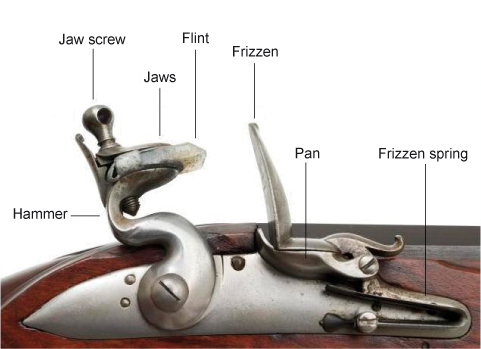5 Thinking about process innovation
Expanding on the OECD/Eurostat (2018) definition, we can suggest the following:
- To qualify as process innovation, a new or improved process should be significantly different to previous processes (e.g. production, distribution and logistics, ICT systems, organisational, marketing and process development) and should have been introduced into use.
Process innovation is traditionally a term to describe innovation in the manufacturing or production processes used to produce a product (a good or service). There are many examples of process innovation, although the revolutionary concept of interchangeable parts in production is perhaps less well-known.
Example 1: Flintlock rifle
An original production process innovation is well-illustrated by the concept of interchangeable parts in flintlock musket rifles (Figure 1). This was demonstrated by the French gunsmith Honoré Blanc in 1785 to an audience of officials, dignitaries and experts (including an enthusiastic future President of the USA, Thomas Jefferson) at the Château de Vincennes near Paris (BBC, 2020).
The demonstration involved taking several rifles apart, putting the components into different boxes, then mixing up the components within the boxes, before reassembling the flintlocks by picking out random parts from each box. This could be done in minutes with little skill required. The demonstration was astonishing to the audience who were used to hand-crafted guns built from parts that were not interchangeable.
The way the mechanism was constructed from separate pieces that could be assembled into the whole rifle was considered revolutionary in its time. If one part became damaged, it could easily be replaced with another. As arms repair was time-consuming highly skilled work, the benefits were evident.
At the time Blanc was unable to find effective solutions to reduce production costs and improve the precision in manufacturing parts. Subsequently, a number of engineering solutions were invented during the Industrial Revolution, which helped to make the system of interchangeable parts work. Interchangeable parts innovation has since revolutionised engineering production and maintenance.
A more recent example of production innovation is the 3D printing process - a rapid prototyping technology that can produce three-dimensional artefacts for testing and for communicating concepts, as well as produce tools for manufacture and one-off or limited batch production. The process of using a device in which thin layers of liquid chemicals are deposited and irradiated with ultraviolet light such that they react to create solid plastic was patented in 1986 by Charles W. Hull (Hull, 1986). By controlling the design of the process with computer software, it is possible to produce successive cross-sections of materials to build a 3D object of choice.
While process innovation is traditionally associated with manufacturing or production processes, the OECD/Eurostat (2018) recognise that all business processes can be innovated and therefore there is recognition of the many types of process innovations. This means that any and all of the following processes can be innovated:
- production process
- distribution and logistics
- information and communication technology systems
- organisational processes (e.g. business practices, workplace organisation, external relations, and administration and management practices)
- marketing processes (marketing and sales/after sales)
- process development.
Innovations in production and business processes – the way things are made, distributed, organised, marketed and developed – can reduce the costs of manufacture, improve performance, affect the costs and the accessibility of products and therefore influence market success. As with Schumpeter’s characterisation of innovation, the OECD/Eurostat (2018) definition represents a broad understanding of innovation and a recognition that innovation is not only associated with technological artefacts or things.
Take a few minutes to think of some of your own examples of innovative processes.

